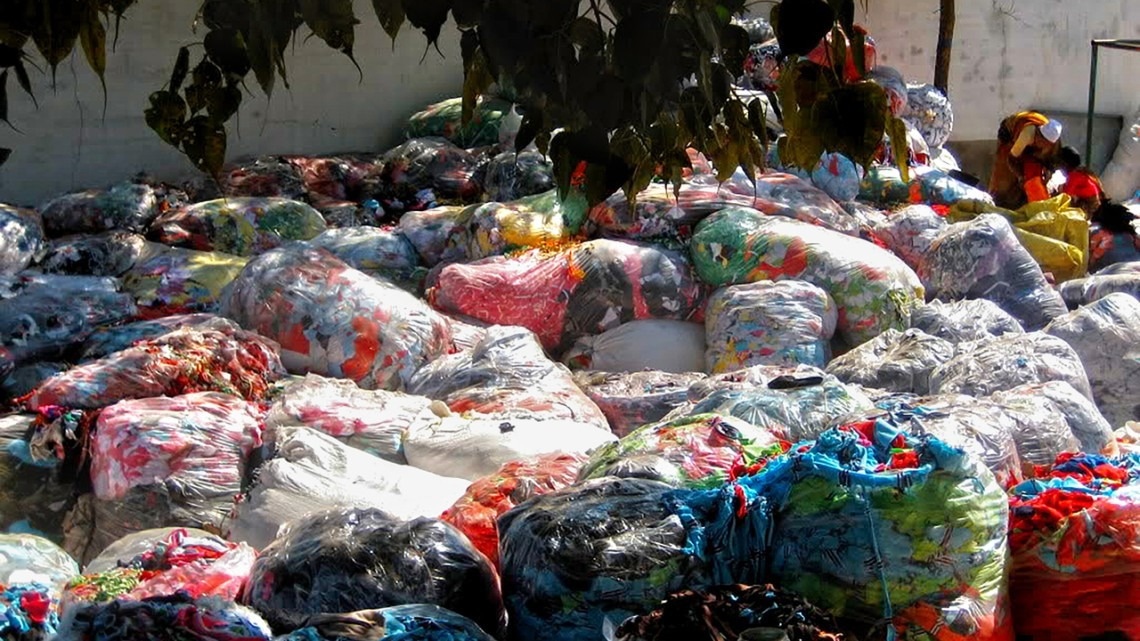In an attempt to make textiles more sustainable, a novel approach enables scientists to break down old clothing chemically and repurpose polyester compounds to produce anti-bacterial, fire-resistant, or wrinkle-free coatings that could further be employed in fabrics and clothes.
 Pieces of discarded textiles outside an apparel manufacturing site in southern India. A large percentage of discarded textiles produced during manufacturing and post-consuming become solid waste and end up being incinerated or dumped in land-fills. Image Credit: Juan Hinestroza
Pieces of discarded textiles outside an apparel manufacturing site in southern India. A large percentage of discarded textiles produced during manufacturing and post-consuming become solid waste and end up being incinerated or dumped in land-fills. Image Credit: Juan Hinestroza
The proof-of-principle study offers hope for unsustainable apparel, textile, and footwear industries that jointly produce 20% of global solid waste. In countries of Asia and Africa, several alleged recyclers end up dumping textiles as trash illegally.
We think that our clothes are recycled or reprocessed, but most of the time they are actually sent to other places as solid waste. Our main goal is to offer a pathway to reuse this material.
Juan Hinestroza, Rebecca Q. Morgan ’60 Professor, Fiber Science & Apparel Design, Cornell University
Hinestroza is also a director of the Textiles Nanotechnology Laboratory in the College of Human Ecology.
The paper was published on March 30th, 2023, in the journal Industrial & Engineering Chemistry Research. It explains the process of cutting textiles into pieces and decomposing them chemically into a soup of dyes, raw materials, additives, esters, and dirt. A metal solution is included and building blocks from the polyester share an affinity with the metal, and selectively link metal compounds together, producing tiny cages (known as metal-organic frameworks) that stay at the bottom of the soup.
Then, the formed cages are used to make coatings, which might need negligible structural tweaks to customize each to particular applications. These might comprise coatings that make antibacterial surgical gowns or scrubs, permanent press shirts that do not wrinkle, or baby or industrial clothes that need fire-retardant protection.
“One goal of my lab is to create a universal coating that will serve all these purposes, though we are still far away from that,” Hinestroza adds.
Yelin Ko is the study’s first author and a doctoral student in the field of human-centered design. Before this study, some thought the impurities and dyes in the mix would obstruct the process; however, this proof-of-principle of the approach—called controlled crystallization—reveals that the polyester-derived linkers can search for and bind to metal compounds in solution, despite other existing materials.
The study explains a closed-loop process, where thrown-away materials may be repurposed and add up to a circular economy—a focus for several sustainability scientists at Cornell, Hinestroza added.
Co-authors of the study are Phillip Milner, Assistant Professor of Chemistry and Chemical Biology in the College of Arts and Sciences, and Tyler Azbell, a doctoral student in Milner’s laboratory.
National Science Foundation partially funded this study.
Journal Reference:
Ko, Y., et al. (2023). Upcycling of Dyed Polyester Fabrics into Copper-1,4-Benzenedicarboxylate (CuBDC) Metal–Organic Frameworks. Industrial & Engineering Chemistry Research. doi.org/10.1021/acs.iecr.3c00226.